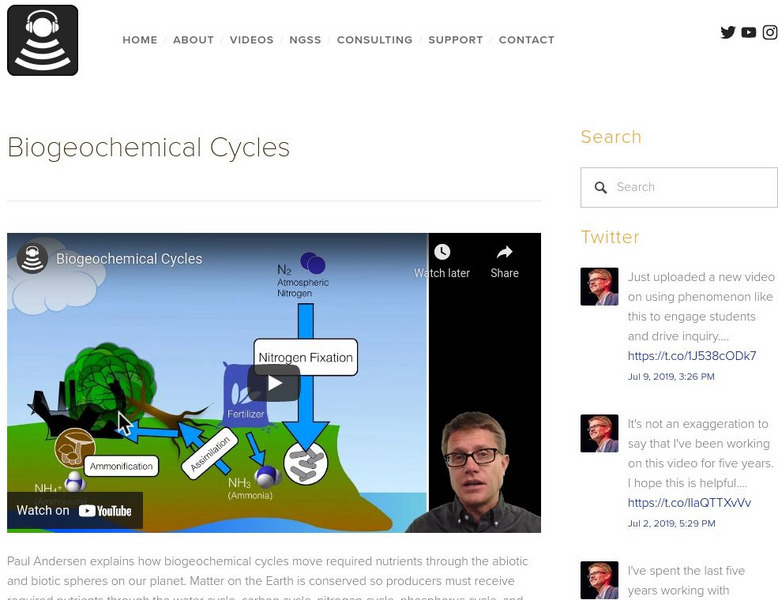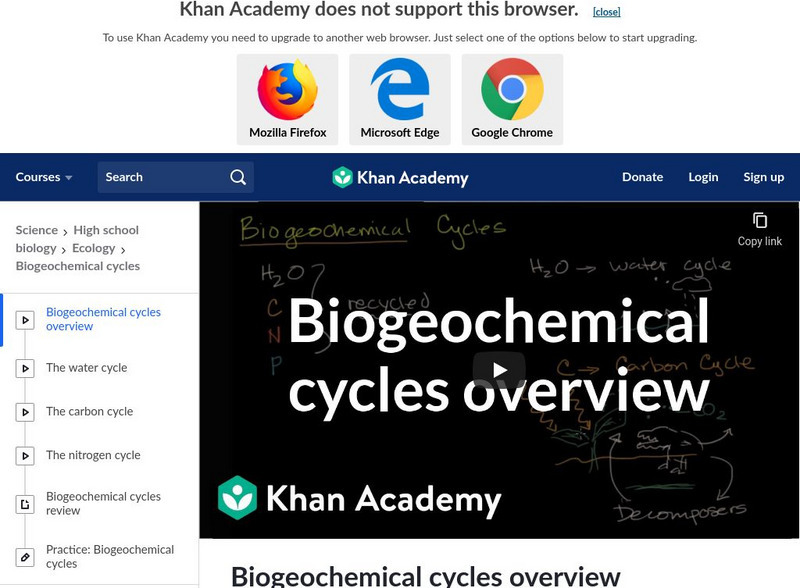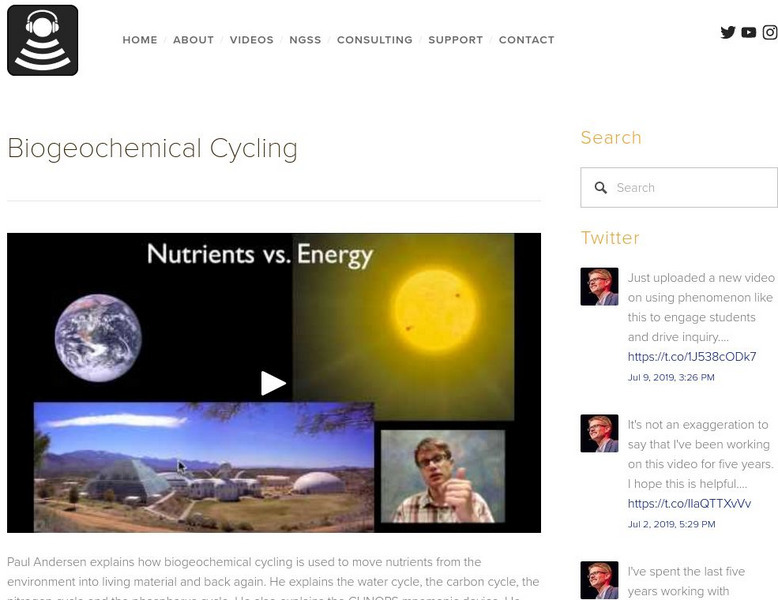Scholastic
Study Jams! The Nitrogen Cycle
Expose your class to the steps of the nitrogen cycle with this short clip. Colorful computer imagery and animation explain how nitrogen travels from the atmosphere as a gas into plants and soil, where bacteria convert it into nitrates....
Amoeba Sisters
Carbon and Nitrogen Cycles
As the world turns ... so do the carbon and nitrogen cycles! Introduce them both to eager young biologists through an animated video, part of an extensive biology playlist. The narrator explains how each element moves through its...
Fuse School
Nitrogen Cycle
In an atmosphere that contains so much unusable nitrogen, how do organisms get the nitrogen they need to survive? The narrated video discusses how atmospheric nitrogen is converted into the materials we need to build proteins in our...
Bozeman Science
Biogeochemical Cycling
A woman had a job crushing cans at the recycling plant; it was soda pressing. Video focuses on the ways our environment recycles, including the water cycle, carbon cycle, nitrogen cycle, and the phosphorus cycle. It also describes the...
Crash Course
Nitrogen and Phosphorus Cycles: Always Recycle! Part 2
We wish you a happy, healthy, and phosphorus school year! A video explains the importance of getting the nutrients that are needed and focuses on the nitrogen and phosphorus cycles. It includes discussions on the importance of bacteria...
Crash Course
The Hydrologic and Carbon Cycles: Always Recycle!
Introduce biogeochemical cycles and goes into detail about the hydrologic and carbon cycles. A scientific video engages learners and teaches them at the same time.
Deep Look
There's Something Very Fishy About These Trees ...
Around 80 percent of the nitrogen in plants living in coastal forests comes from decaying fish. Viewers learn how salmon encourage the growth of forests with a scientific video that highlights interdependence, ecosystems, and the...
Howard Hughes Medical Institute
Termite Activity Enhances Ecosystem Productivity and Stability
Termites in your house? Bad. Termites in your garden ... good? Discover the good side of an insect that often gets a bad rap with an interesting animation. The narrator discusses how termites break down plant material, what the soil...
Crash Course
Pollution
An environmental science video covers natural and synthetic compounds and the impact they have on the environment. It includes carbon, nitrogen, phosphorous, cyanide, mercury, sulfur, nitrogen dioxide, and endocrine disruptions.
Fuse School
How Burning Fossil Fuels Leads to Climate Change
Do our vehicles really contribute to global warming? In part five of an eight-video series, pupils learn the mechanisms by which car emissions turn into greenhouse gases. Through animation, the class sees how the natural greenhouse...
Crash Course
Ecosystem Ecology: Links in the Chain
A video starts by defining an ecosystem. It expands on the concept by covering trophic structure, primary producers, primary consumers, secondary consumers, tertiary consumers, detrivores, and bioaccumulation.
Khan Academy
Khan Academy: Ecology: The Nitrogen Cycle
Learn how nitrogen is recycled in our biosphere in the nitrogen cycle, including nitrogen fixation. [5:44]
PBS
Pbs Learning Media: Crash Course Ecology: Nitrogen & Phosphorus Cycles: Always Recycle! Part 2
Hank describes the desperate need many organisms have for nutrients (specifically nitrogen and phosphorus) and how they go about getting them via the nitrogen and phosphorus cycles. [9:21]
Bozeman Science
Bozeman Science: Biogeochemical Cycles
Paul Andersen explains how biogeochemical cycles move required nutrients through the abiotic and biotic spheres on our planet. Matter on the Earth is conserved so producers must receive required nutrients through the water cycle, carbon...
Crash Course
Crash Course Ecology #9: Nitrogen & Phosphorus Cycles: Always Recycle Part 2
Hank describes the desperate need many organisms have for nutrients (specifically nitrogen and phosphorus) and how they go about getting them via the nitrogen and phosphorus cycles. [9:23]
Khan Academy
Khan Academy: Ecology: Biogeochemical Cycles Overview
Introduction to how water, carbon, nitrogen, and phosphorus are cycled through ecosystems. [7:54]
Khan Academy
Khan Academy: Biogeochemical Cycles Overview
Introduction to how water, carbon, nitrogen, and phosphorus are cycled through ecosystems. [7:55]
Bozeman Science
Bozeman Science: Biogeochemical Cycling
Paul Andersen explains how biogeochemical cycling is used to move nutrients from the environment into living material and back again. He explains the water cycle, the carbon cycle, the nitrogen cycle and the phosphorus cycle. He also...



















